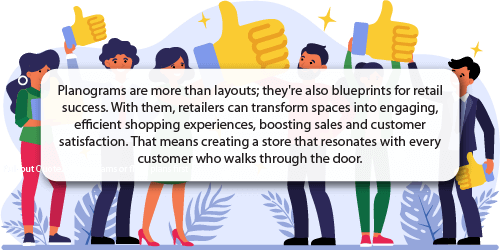In the bustling world of medium-sized retail, the strategic use of planograms is paramount. After all, these visual merchandising tools not only help retailers organize store layouts but also strategically enhance the shopping experience. That’s why practical planogram tips are always needed. That’s especially true when retailers consider the nuances of retail planogram design, understanding how they directly influence customer engagement, product visibility, and more.

The 'Why' behind effective planogram design is pivotal for medium-sized retailers. It's not just about aesthetics. Creating retail planograms means designing a shopping environment that resonates with customer needs and preferences. Effective planogramming can significantly boost sales and customer satisfaction by ensuring products are easily accessible and appealingly displayed, making every square foot of retail space a testament to thoughtful planogram design and business success.
Of course, understanding the 'How' of planogram design is just as crucial. By using planograms strategically, retailers can not only optimize their space but also significantly enhance product visibility, and improve customer flow. So, how can retailers achieve that? We unpack that below, delving into various practical planogram tips that are essential for retail space optimization and creating inviting shopping environments.

Incorporate strategic product placement into planogram design for optimal retail impact
The strategic placement of products on the shelf is a critical factor in driving sales and enhancing customer experience. The key is to position items for maximum visibility and accessibility, thereby improving the customer's shopping journey and increasing the likelihood of purchase.
Leveraging sales data and customer analytics in planogram strategy
One effective method for optimal product placement within retail planograms is through sales data analysis and customer behavior analytics.
For example, products strategically positioned at eye level sell better than those placed on higher or lower shelves. DotActiv clients like Makro and Dis-Chem often use this strategy, placing high-demand items at eye level to boost sales.
Supermarkets like Food Lover's Market also provide a classic example of strategic product placement in their planogram design. Essentials like bread and milk are often strategically located at the back, encouraging a comprehensive customer journey through various aisles, potentially leading to impulse buys. It is a layout design based on customer flow patterns and purchasing habits, ensuring maximum exposure to a wide range of products.
High-traffic areas in retail planograms: a goldmine for impulse purchases
High-traffic areas within a store are goldmines for placing impulse purchase items.
For example, stores often have small but inexpensive items at their checkout counter. These are there for stores to capitalize on the customer's waiting time, increasing the likelihood of last-minute purchases.
Seasonal and promotional displays
Incorporating seasonal and promotional displays is a vital aspect of strategic product placement. Utilizing these displays effectively within the planogram design can significantly attract customer attention and drive seasonal sales.
During the holiday seasons, stores like Macy's and Nordstrom create such displays at the front of the store or in central locations to attract customers and promote seasonal products.
Incorporating flexibility in product placement
Flexibility is also crucial when it comes to strategic product placement. Retailers should be ready to adjust their planogram strategies based on evolving trends and customer feedback, ensuring their store layout remains dynamic and customer-centric.
For example, during the holiday season, retailers can highlight gift items or seasonal goods.
Strategic product placement is not a one-time task but a continuous process. Retailers must continually analyze sales data, monitor customer behavior, and adjust their planogram strategies to ensure they stay relevant and effective. By doing so, they can ensure that their products are always placed in the most effective locations, leading to increased sales and a better shopping experience.

Optimize shelf space and height in retail planograms
Using shelf space and height effectively is crucial for maximizing product visibility and enhancing customer experience. A well-thought-out planogram that optimizes shelf space can significantly impact sales and store efficiency.
It involves a strategic approach to displaying products, considering both the vertical and horizontal dimensions of shelving.
Maximizing visibility with vertical space
The vertical arrangement of shelves significantly influences customer interaction with products. Mastering this aspect in planogram design can lead to improved product engagement and customer convenience.
Retailers like IKEA are known for using vertical space efficiently, displaying a wide range of products without overwhelming customers. The key is to place high-demand items at eye level while storing less popular or bulk items higher or lower on the shelves.
Grocery stores are prime examples here. They place essentials like cereals and snacks at eye level of adults and parents, while they place children's products lower, within their line of sight. This strategic placement not only makes products more accessible but also caters to the specific target audience.
Balancing product display against horizontal space
Alongside vertical space optimization, the horizontal arrangement of products in retail planograms is equally crucial. Retailers must balance the number of products on a shelf to avoid a cluttered look.
For example, fashion retailers often use spaced-out horizontal displays to highlight individual clothing items, making it easier for customers to browse and select products.
Adjusting shelf height for accessibility
Adjusting shelf height based on product type and target customers is another aspect of optimizing shelf space and is a key element in planogram design. At general merchandise stores like Makro, the retailer places heavier and bulkier items on lower shelves for safety and ease of access, while also placing lighter items higher up.
Incorporating flexibility in shelf arrangement
Flexibility in shelf arrangement is crucial for dynamic retail planogram management, especially for stores that frequently update their inventory based on seasons or trends. Modular shelving systems, for example, allow retailers to adjust shelf height and spacing easily to accommodate different product sizes and types.
Optimizing shelf space and height is a dynamic process that requires continuous evaluation and adjustment. Retailers must consider both the aesthetic appeal and practicality of their shelf arrangements. By doing so, they can create an inviting and efficient shopping environment that enhances product visibility, improves accessibility, and ultimately drives sales.

Be flexible to account for seasonal changes in retail planogram design
A retailer's ability to adapt to changing market trends, seasonal shifts, and promotional events is crucial. Designing retail planograms for scalability and flexibility allows retailers to stay relevant and responsive to customer needs.
Embracing seasonal changes
Seasonal changes greatly influence consumer purchasing behavior. Any retailer can excel in this area by redesigning their planogram strategies to highlight seasonal products and adapting their layouts to these shifts
For example, stores can rearrange their planograms to feature holiday decorations, gifts, and seasonal food items in prominent areas, creating a festive and inviting atmosphere.
Adapting to market trends
Staying abreast of market trends is vital for retailers, particularly in planogram design and layout strategy.
Fashion retailers often redesign their store layouts to showcase the latest fashion trends. By refreshing their planograms regularly, stores can keep their stock fresh and exciting, encouraging repeat visits from customers eager to see the latest styles.
Flexibility for promotional events
Promotional events are key opportunities for retailers to boost sales, especially through flexible retail planogram designs.
A DotActiv client like electronics retailer InMotion can rearrange their layouts to highlight promotional items during Black Friday sales. It involves creating flexible retail planograms that accommodate larger displays for featured products, ensuring they capture customer attention.
IKEA is another example of a retailer that has mastered the art of flexible planogram design.
Their modular furniture displays allow for easy rearrangement to accommodate new products or design trends. This approach not only keeps the store layout fresh but also demonstrates the versatility of their products.
Incorporating digital tools for planogram management
Modern retailers are increasingly turning to digital tools for efficient planogram management, adapting quickly to market changes. A planogram software solution such as DotActiv allows for quick and efficient layout changes, enabling stores to respond rapidly to market shifts.
Such a tool also provides valuable data insights, helping retailers make informed decisions about product placement and store design.
Designing for scalability and flexibility in retail planograms is essential for meeting ever-changing market demands and consumer preferences.
By creating adaptable store layouts, retailers can ensure a continually engaging and relevant shopping experience. This dynamic approach to planogram design is vital to maintaining customer interest and driving sales in a competitive retail landscape.

Leverage technology for enhanced planogram efficiency in retail design
Planogram design software and technology have revolutionized how retailers present and manage their stores. Today, software plays a critical role in creating efficient and effective retail planograms. Meanwhile, retailers also need to consider tools like 3D modeling and data analytics in planogram design.
3D modeling is a game-changer for visualizing retail planogram space
3D modeling software has become a game-changer in planogram design.
How so?
Retailers can use 3D visualization tools to create lifelike models of their store layouts, allowing them to experiment with different retail planogram designs before implementing them.
Such technology enables retailers to visualize how products will look on shelves and how customers will interact with the space, leading to more informed decisions about product placement and store design.
Data analytics for informed decision-making in planogram design
Data analytics also plays a crucial role in planogram efficiency.
DotActiv service clients like Makro, Dis-Chem, Ultra Liquors, Food Lover's Market, and others utilize data analytics to understand customer behavior, sales patterns, and product performance.
This data-driven approach informs our retail planogram decisions, ensuring we place their high-demand products in prime locations and optimize their store layouts for maximum sales potential.
Using data-driven retail planograms for enhanced store layouts
Food Lover's Market provides a few compelling case studies around data-driven planograms. DotActiv has completed a handful of case studies detailing their success.
By analyzing its sales data and customer traffic patterns, Food Lover's Market tailors its planogram strategies to local customer preferences, ensuring that each store stocks the right products in the right places for optimal retail planogram efficiency. This approach has led to increased customer satisfaction and sales.
Enhancing store management with technology in planogram strategy
Beyond design, technology also enhances overall store management.
Inventory management systems integrated with planogram software enable retailers to track stock levels in real-time, ensuring shelves are stocked with the right products for effective retail planogram management.
This integration reduces the risk of stockouts and overstocking, improving the overall efficiency of store operations.
The future of retail: augmented reality and AI in planogram innovation
Looking to the future, technologies like augmented reality (AR) and artificial intelligence (AI) will further transform planogram design if they haven't already started.
AR provides immersive experiences, allowing store managers to walk through their store layouts virtually. Think of it as an opportunity to walk in the shoes of customers to understand how they experience a store.
On the other hand, AI predicts customer preferences and suggests optimal product placements, making planogram design more responsive and customer-centric.
Leveraging technology in planogram design and management is essential for modern retailers. The use of 3D modeling, data analytics, and emerging technologies like AR and AI not only enhances the efficiency of store layouts but also provides a more personalized shopping experience for customers.
As retail continues to evolve, embracing these technological advancements will be critical to staying competitive and meeting the ever-changing needs of consumers.
Conclusion: Elevating medium-sized retail with advanced planogram tips
Using any or all of these practical planogram tips can significantly enhance the efficiency and appeal of medium-sized retail stores. But it shouldn't end there. These tips are only the start - building effective retail planograms starts with the best advice and continues by using them in specialist software.
Interested in building planograms? Why not try a free 14-day trial of DotActiv software today? Get access to a free trial of any software edition on DotActiv’s online store.


